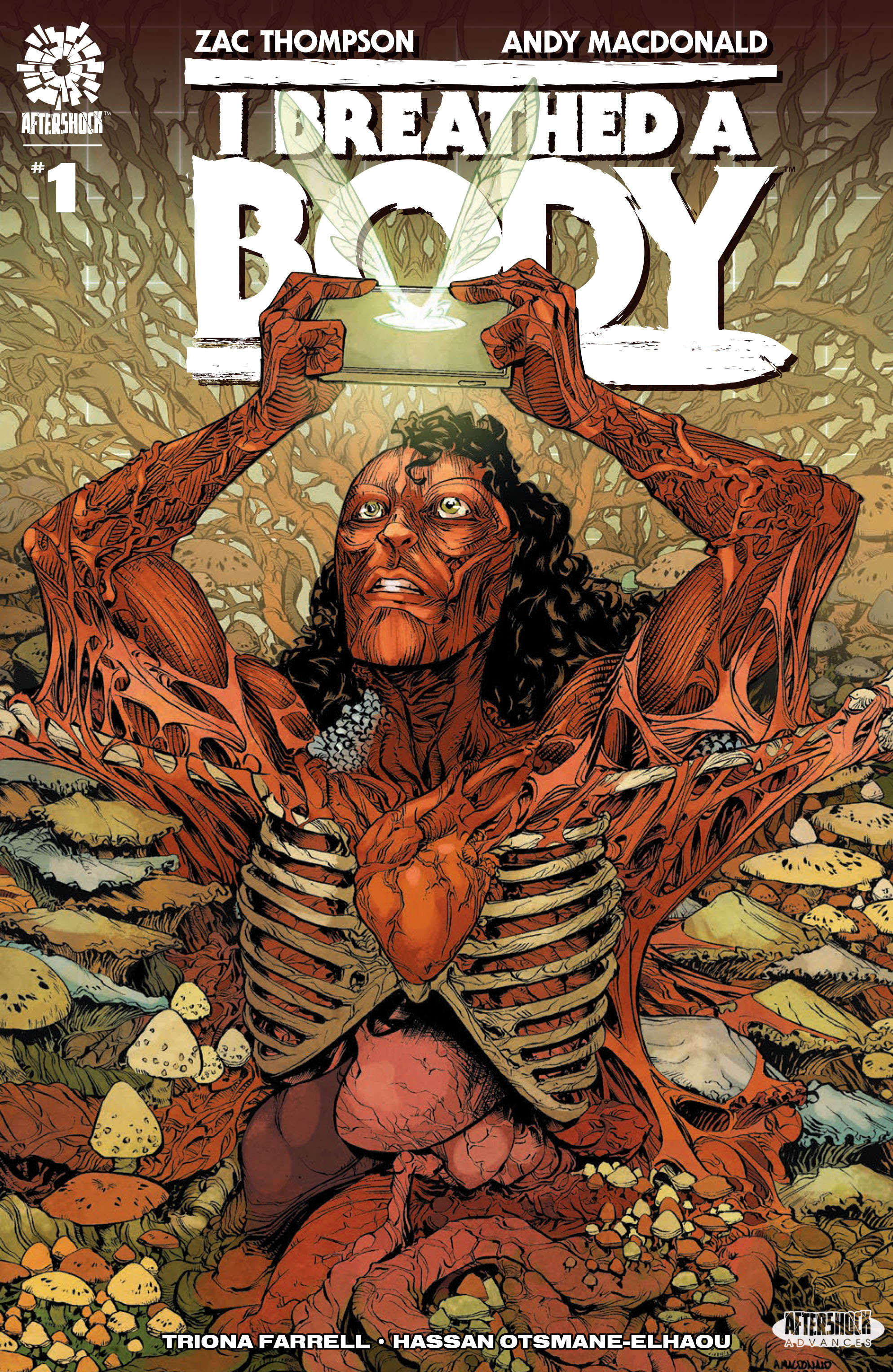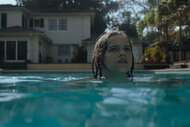Create a free profile to get unlimited access to exclusive videos, sweepstakes, and more!
Zac Thompson probes the horrors of social media in high-concept new comic 'I Breathed a Body'

Some stories grow slowly over time, so slowly that their creators sometimes can't remember the moment that they sparked to life. That's not the case for writer Zac Thompson's new horror comic I Breathed a Body. For Thompson, the moment the upcoming AfterShock Comics series took root is still crystal clear: It was three years ago, amid YouTuber Logan Paul's infamous Japanese Suicide Forest video controversy. Thompson, who was working as a video producer for a company attempting to work with Paul at the time, recalls having a visceral reaction to the callous and opportunistic way other people in meetings with him reacted to that particular internet firestorm.
"As they rationalized, many communicated they were more than okay with the idea [of filming a body and posting it online]. They were quick to dismiss the politics of filming a dead body. The meeting concluded with a certainty that people would forget about it in a day," Thompson told SYFY WIRE. "That really stuck with me. I couldn’t believe I was watching professionals discuss whether or not it was okay to film a corpse and show it to hundreds of millions of people. It felt like this strange type of internet voyeurism taken to the logical extreme. I was reading a lot of Clive Barker at the time and it just struck me that this was the future of 'content.' Transgression drives metrics on social media. It felt like an inevitability that eventually we’d be in a future indifferent to our suffering, indifferent to our pain, or what type of content we’re unleashing into the world. That moment is burned into my brain forever, so I took my personal horror to its logical extreme and created I Breathed A Body."
As its origin story might suggest, Thompson views I Breathed a Body as an indictment of Big Tech that grew out of his own experiences working with influencers and internet personalities, and an exploration of what he called "the voyeurism of violence" in a press release announcing the book last year. But if you're familiar with Thompson's comics at all, you know that you're in store for something much more than a dry, straightforward rebuke of internet culture in comic form. Like his other recent horror success, Lonely Receiver, I Breathed a Body's thematic core of violence, voyeurism, and disposable internet carnage is sheathed in a supernatural aura of near-future design, Cronenbergian dread, and a blurring of the lines between technology and magic.
"Good horror, to me, is all about a gradual descent. It’s about confronting something uncanny and letting the reader sit with it for a moment," Thompson said. "Letting the characters experience this unease as the tension winds around them, coiling slowly as they realize they're trapped. So at first it becomes this sensation that things are slightly off, that maybe you should run. But before long, as the characters keep sinking into dread, those thoughts are replaced by more primal ideas. The idea of survival, or what it means to be human, or if there’s some primordial being controlling the fabric of reality. Horror, for me, is about confronting fundamental questions about what it means to be human in an ever changing world."
To confront the questions at work in I Breathed a Body, Thompson, artist Andy MacDonald, colorist Triona Farrell, and letterer Hassan Otsmane-Elhaou begin with the point-of-view of Anne Stewart, a smart but frayed social media manager working for the biggest internet personality in the world, a young man named Mylo Caliban who seems engineered to generate some form of controversy, and therefore engagement and profit, with every single video he streams. As we meet her, Anne is preparing to leverage her success with Mylo into something more, but then Mylo posts something horrific even by his daring standards, leaving Anne to descend into a terrifying new form of internet fallout she might not be prepared for. In the exclusive preview pages below (some NSFW language in the dialogue), we see Anne just beginning to work on leveraging Mylo's success with her boss, unaware of what's about to hit them all.
As Thompson and company plunge readers into I Breathed a Body's dark world, they will see a great many things they recognize: The rich getting richer, devices with a tight grip on the daily lives of characters, an internet personality who's adept at spinning any narrative to be about their own personal journey, and of course a publicity machine designed to get maximum traction out of any audience. That's all by design, but so is the more supernatural element of the book, which arrives both in the form of an underlying (and terrifying) backstory hinted at in the opening pages and in the central visual metaphor Thompson chose for this project: Mushrooms, and how they grow and thrive.
"I knew I Breathed a Body was going to be inspired by Clive Barker and a persistent theme in this work is duality. The idea that there’s a razor thin line between pleasure and pain, life and death, etc. Mushrooms seemed like a natural fit within this framework," Thompson said. "Many species are neither living nor dead, they can transform biological material without living themselves, they can take root in concrete, repurpose rot… the possibilities are endless. But more than anything, they are these vastly connected creatures with no central nervous system, no evolutionary hierarchy, no fixed place within nature. They are decentralized and yet they all work together. Mushrooms became this incredibly apt way to talk about the vast and sprawling nature of the internet. Quickly I found myself using actual fungal science to create the mycelium-based internet at the heart of the story. They are the central visual metaphor, something familiar but ultimately foreign to us. We think we understand mushrooms, but we’ve barely scratched the surface of their potential. Just like the internet!"
All of these ideas converge to form a compelling story, of course, but to really make I Breathed a Body's fungal themes and designs work on the comics page, Thompson needed the right artist, which he found in MacDonald.
"I’ve been a fan of Andy for years, and when the chance to work together came up - I jumped all over it. There is a sincere effort to gross you out with this book and I knew that Andy’s linework could communicate the revolting nature of what we wanted to capture. I knew he was someone who could literally draw anything I threw at him," Thompson explained. "And that his versatility would come in handy as the book becomes less restrained in the final issues. But there’s a sincere emotional core behind it all, where you can see the pain on people’s faces and empathize with it. That was key for something like this because it all means nothing if you don’t empathize with those lost in this madness."
This "madness," as Thompson called it, is of course heavily inspired by our modern technological landscape and Thompson's own time as a participant in it. I Breathed a Body holds little back in the horror department, sinking readers into a sense of dread that builds to a crescendo by the end of the first issue, only to pick up again in even more dread-laden ways by the second. It's a visceral book in more ways than one, and given its personal roots, it makes sense that Thompson himself has come to view the internet differently thanks to his time working on it.
"Working on I Breathed A Body has convinced me to turn off all notifications on every social media platform, to curb my use of these apps and to ensure I’m not divulging too much of my personal life online," Thompson said. "It’s made me realize how much social media has caused our ideas of ourselves to fracture. It’s becoming harder to reconcile where I end and you begin thanks to the internet and we’re never really going to be able to put that genie back in the bottle."
I Breathed a Body arrives in comics shop January 20.














